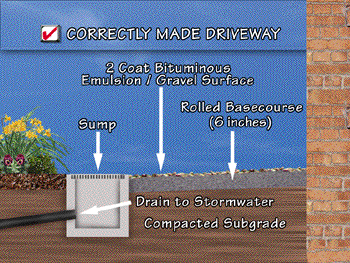Driveway Tips
‘Burke’s Backyard’ visited a home in Sydney where a recently-constructed driveway had begun to disintegrate. The gravel drive had become pot-holed after only four years of use. This prompted advice on the correct way to make a driveway.
Checklist for a well made driveway
A well-made driveway should provide more than 20 years of service. If your driveway begins to show signs of wear and tear after only a few years then it has not been properly constructed.
There are certain points to consider when planning a driveway to ensure that it is long lasting and effective. Whether you are putting the driveway in yourself or paying someone else to install it, here are some helpful points to consider:
Preparation is critical. The subgrade (base of the driveway after excavation) must be compacted with a roller before the basecourse is laid (see diagram).
Make sure the basecourse of the driveway is level. To do this lay a 15cm (6″) base of roadbase or fine crushed sandstone material and compact it with a vibrating roller. When constructing a paved driveway use sand as the basecourse.
Next put two coats of cold seal tar (bituminous emulsion) with a layer of gravel (for example Nepean River gravel) in between. Top this with another layer of gravel after the final coat of tar for the final finished look.
Note: For bituminous emulsion sealed roads (cold tar) use any aggregate or gravel which does not generate dust, such as blue metal. Red bauxite is not suitable because of the dust which it generates.
For any other driveway finish such as brick, pavers, concrete rock or bituminous concrete the same base preparations are needed.
Drainage is another essential aspect of a driveway. The drive should not drain towards the house at any point. There should be a drainage system installed with pits or sumps (pre-cast concrete pit) in the driveway covered with a removable grate. At the bottom of the pits there should be a 15-30cm (6-12″) plastic pipe taking the water off to a storm water drain. The pipe needs to be raised off the bottom of the pit to allow the water to drain away and prevent the gravel that falls into the pit, blocking the entrance to the pipe (see diagram).
Further information
The Landscape Contractors Association of Australia may be able to suggest a member to advise on the construction of driveways on your property.
New South Wales & ACT
Landscape Contractors’ Association of New South Wales
Phone: (02) 9790 5151
Queensland
Queensland Association of Landscape Industries
Phone: (07) 3847 8365 Fax: (07) 3847 8359
Email: [email protected]
Website: www.qali.asn.au
South Australia
Landscape Association of South Australia Inc
Phone: (08) 8210 5211
Tasmania
Landscape Industries Association of Tasmania
Phone: (03) 6425 5253
Victoria
Landscape Industries Association of Victoria and Landscape Industries Association of Australia
Phone: (03) 9889 0078
Western Australia
Landscape Industries Association of Western Australia
Phone: (08) 9244 3560



